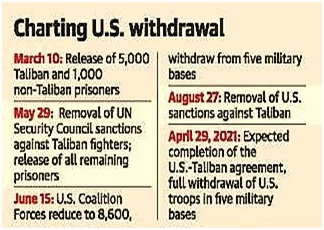US-Taliban Pact
- 07 Mar 2020
- On 29th February, 2020, the US and Taliban signed an agreement for “Bringing Peace to Afghanistan”, which will enable the US and NATO to withdraw troops in the next 14 months and to facilitate intra-Afghan dialogue in Oslo (Norway) starting from 10th March, 2020.
- India attended the signing ceremony which was held in Doha, Qatar.
Key Elements of the Pact
- Troops Withdrawal: The US will draw down to 8,600 troops in 135 days and the NATO or coalition troop numbers will also be brought down, proportionately and simultaneously.
- Counter-terrorism Assurances: The main counter-terrorism commitment by the Taliban is that it will not allow any of its members, other individuals or groups, including al-Qaeda, to use the soil of Afghanistan to threaten the security of the United States and its allies.
- Sanctions Removal: UN sanctions on Taliban leaders to be removed by three months (by May 29, 2020) and US sanctions by August 27, 2020.
- Prisoner Release: The US-Taliban pact says up to 5,000 imprisoned Taliban and up to 1,000 prisoners from “the other side” held by Taliban “will be released” by 10th March, 2020.
- Ceasefire: The agreement states that, ceasefire will be simply “an item on the agenda” when intra-Afghan talks start and indicates actual ceasefire will come with the “completion” of an Afghan political agreement.
 Source: The Hindu
Source: The Hindu
Challenges
- There are still many issues remain to be worked out during intra-Afghan negotiations, including sharing power, disarming and reintegrating Taliban fighters into society, and determining the future of the country’s democratic institutions and constitution.
- The process could be complicated by a weak central government, afflicted by ethnic, sectarian, and tribal differences, which may descend into open conflict and might start the next round of civil war, hampering the peace deal.
- At the same time, experts say the Taliban is stronger now than at any point in the last eighteen years. It earns millions of dollars from opium poppy cultivation and the illegal drug trade. Some analysts are also worried that rank-and-file Taliban fighters might not abide by a peace deal.
Impact on Afghanistan
- The U.S. withdrawal will invariably weaken the Kabul government, altering the balance of power both on the battlefield and at the negotiating table.
- The Taliban have got what they wanted: Troops withdrawal, removal of sanctions, and release of prisoners. This has also strengthened Pakistan, Taliban’s benefactor, and the Pakistan Army and the ISI’s influence appears to be on the rise.
- Further, the social change brought about by two decades of US presence in Afghanistan — human rights, female emancipation, entertainment — could be in peril.
- The future for the people of Afghanistan is uncertain, and will depend on how Taliban honours its commitments and whether it goes back to the mediaeval practices of its 1996-2001 regime.
Impact on India
- The Taliban perceived India as a hostile country, as India had supported the anti-Taliban force Northern Alliance in the 1990s.
- India never gave diplomatic and official recognition to the Taliban when it was in power during 1996-2001.
- The peace deal holds strategic and geopolitical implications for the country, which has invested billions of dollars in Afghanistan.
- The decision to withdraw precipitously from Afghanistan is likely to have far-reaching consequences for India – an increase in Taliban’s influence in Afghanistan could negatively impact the security situation in the restive Kashmir valley.
- Further, the pact is silent on other terrorist groups — such as anti-India groups like Lashkar-e-Toiba or Jaish-e-Mohammed. Again, India, not being an US ally, is not covered under this pact.
- The deal also holds significance in terms of the strained relations with Pakistan which has interests in the region.
- With US withdrawal from Afghanistan, Pakistan will indeed become an important player. And India’s security in the region would be far more vulnerable than it is today.
Way Forward
- The withdrawal of US forces has the probability of the creation of vacuum in the region and possibility of filling the void by terrorists and extremists.
- US, along with other stakeholders in the region like India, Russia and Chinashould be prepared for a long-term diplomatic engagement with Afghanistan, which will involve simultaneously strengthening the country’s political mainstream and integrating the Taliban within it.
- The challenges ahead are formidable. There is hope, but skepticism runs deeper.




